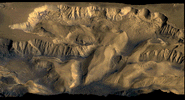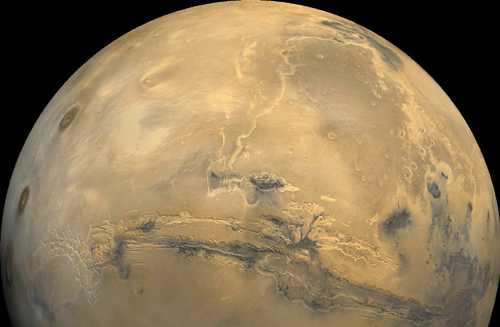
 |

See
 Mars is the fourth planet from
the Sun and the seventh largest:
Mars is the fourth planet from
the Sun and the seventh largest: orbit:
227,940,000 km (1.52 AU) from Sun
diameter: 6,794 km
mass: 6.4219e23 kg
Mars (Greek:
Ares)
is the god of War. The planet probably got
this name due to its red color; Mars is sometimes referred to
as
the Red Planet. (An interesting side note: the Roman god Mars
was a god of
agriculture before becoming associated with the Greek Ares; those
in favor of
colonizing and terraforming Mars may prefer this symbolism.)
The name of the month March
derives from Mars. Mars has been known since prehistoric times. It is still a favorite of science fiction writers as the most favorable place in the Solar System (other than Earth!) for human habitation. But the famous "canals" "seen" by Lowell and others were, unfortunately, just as imaginary as Barsoomian princesses.
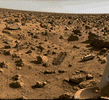
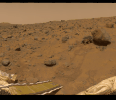 The
first spacecraft to visit Mars was
Mariner 4 in 1965.
Several others followed including
Mars
2,
the first spacecraft to land on Mars and
the two Viking landers in
1976 (left).
Ending a long 20 year hiatus, Mars Pathfinder
landed successfully on Mars on 1997 July 4 (right).
The
first spacecraft to visit Mars was
Mariner 4 in 1965.
Several others followed including
Mars
2,
the first spacecraft to land on Mars and
the two Viking landers in
1976 (left).
Ending a long 20 year hiatus, Mars Pathfinder
landed successfully on Mars on 1997 July 4 (right).
Mars' orbit is significantly elliptical. One result of this is a temperature variation of about 30 C at the subsolar point between aphelion and perihelion. This has a major influence on Mars' climate. While the average temperature on Mars is about 218 K (-55 C, -67 F), Martian surface temperatures range widely from as little as 140 K (-133 C, -207 F) at the winter pole to almost 300 K (27 C, 80 F) on the day side during summer.
Though Mars is much smaller than Earth, its surface area is about the same as the land surface area of Earth.
Except for Earth, 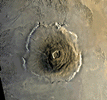 Mars has the most highly varied and
interesting terrain of any of the terrestrial planets, some of it quite
spectacular:
Mars has the most highly varied and
interesting terrain of any of the terrestrial planets, some of it quite
spectacular:
- Olympus Mons: the largest mountain in the
Solar System rising 24
km (78,000 ft.) above the surrounding plain. Its base is
more than 500 km
in diameter and is rimmed by a cliff 6 km (20,000 ft)
high
(right).
- Tharsis: a huge bulge on the Martian surface that is
about 4000 km
across and 10 km high.
- Valles Marineris: a system of canyons 4000 km long
and from 2 to
7 km deep (top of page);
- Hellas Planitia: an impact crater in the southern
hemisphere over
6 km deep and 2000 km in diameter.
Much of the Martian surface is very old
and cratered,
but there are also much younger rift valleys, ridges, hills and
plains.
![]() The southern hemisphere of Mars is predominantly
ancient cratered
highlands (left) somewhat similar to the Moon.
In contrast, most of the northern hemisphere consists of plains
which
are much younger, lower in elevation and have a much more
complex
history.
An abrupt elevation change of several kilometers seems to occur
at the boundary.
The reasons for this global dichotomy and abrupt boundary are
unknown (some speculate that they are due
to a very large impact shortly after Mars' accretion).
Mars Global
Surveyor.has produced a nice
3D
map
of Mars that clearly shows these features.
The southern hemisphere of Mars is predominantly
ancient cratered
highlands (left) somewhat similar to the Moon.
In contrast, most of the northern hemisphere consists of plains
which
are much younger, lower in elevation and have a much more
complex
history.
An abrupt elevation change of several kilometers seems to occur
at the boundary.
The reasons for this global dichotomy and abrupt boundary are
unknown (some speculate that they are due
to a very large impact shortly after Mars' accretion).
Mars Global
Surveyor.has produced a nice
3D
map
of Mars that clearly shows these features.
The interior of Mars is known only by inference from data about the surface and the bulk statistics of the planet. The most likely scenario is a dense core about 1700 km in radius, a molten rocky mantle somewhat denser than the Earth's and a thin crust. Data from Mars Global Surveyor indicates that Mars' crust is about 80 km thick in the southern hemisphere but only about 35 km thick in the north. Mars' relatively low density compared to the other terrestrial planets indicates that its core probably contains a relatively large fraction of sulfur in addition to iron (iron and iron sulfide).
Like Mercury and the Moon, Mars appears to lack active plate tectonics at present; there is no evidence of recent horizontal motion of the surface such as the folded mountains so common on Earth. With no lateral plate motion, hot-spots under the crust stay in a fixed position relative to the surface. This, along with the lower surface gravity, may account for the Tharis bulge and its enormous volcanoes. There is no evidence of current volcanic activity, however. But there is new evidence from Mars Global Surveyor that Mars may have had tectonic activity in its early history, making comparisons to Earth all the more interesting!
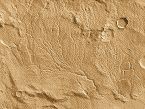 There is very clear evidence of erosion in many
places on Mars
including large floods and small river systems (right).
At some time in the past there was clearly some sort of fluid on the surface.
Liquid water is the obvious fluid but
other possibilities exist.
There may have been large lakes or even oceans; the evidence for which was
strenghtened by some very nice images of layered terrain taken by Mars Global Surveyor.
But it seems that this occurred only briefly and very long ago;
the age of the
erosion channels is estimated at about nearly 4 billion years.
(Valles Marineris was NOT created by running water.
It was formed by the stretching and cracking of the crust
associated with the creation of the Tharsis bulge.)
There is very clear evidence of erosion in many
places on Mars
including large floods and small river systems (right).
At some time in the past there was clearly some sort of fluid on the surface.
Liquid water is the obvious fluid but
other possibilities exist.
There may have been large lakes or even oceans; the evidence for which was
strenghtened by some very nice images of layered terrain taken by Mars Global Surveyor.
But it seems that this occurred only briefly and very long ago;
the age of the
erosion channels is estimated at about nearly 4 billion years.
(Valles Marineris was NOT created by running water.
It was formed by the stretching and cracking of the crust
associated with the creation of the Tharsis bulge.)
Early in its history, Mars was much more like Earth. As with Earth almost all of its carbon dioxide was used up to form carbonate rocks. But lacking the Earth's plate tectonics, Mars is unable to recycle any of this carbon dioxide back into its atmosphere and so cannot sustain a significant greenhouse effect. The surface of Mars is therefore much colder than the Earth would be at that distance from the Sun.
Mars has a very thin atmosphere composed mostly of the tiny amount of remaining carbon dioxide (95.3%) plus nitrogen (2.7%), argon (1.6%) and traces of oxygen (0.15%) and water (0.03%). The average pressure on the surface of Mars is only about 7 millibars (less than 1% of Earth's), but it varies greatly with altitude from almost 9 millibars in the deepest basins to about 1 millibar at the top of Olympus Mons. But it is thick enough to support very strong winds and vast dust storms that on occasion engulf the entire planet for months. Mars' thin atmosphere produces a greenhouse effect but it is only enough to raise the surface temperature by 5 degrees (K); much less than what we see on Venus and Earth.
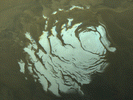 Mars has permanent ice caps at both poles
composed of water ice and solid carbon dioxide ("dry ice").
The ice caps exhibit a layered structure with alternating layers
of ice
with varying concentrations of dark dust.
In the northern summer the carbon dioxide completely
sublimes, leaving
a residual layer of water ice.
It seems likely that a similar layer of water ice
exists below the southern cap (left) as well.
The mechanism responsible for the layering is unknown but may be
due to
climatic changes related to long-term changes in the
inclination of Mars' equator to the plane of its orbit.
There may also be water ice hidden below the surface at lower
latitudes.
The seasonal changes in the extent of the polar caps changes the
global atmospheric pressure by about 25% (as measured at the
Viking
lander sites).
Mars has permanent ice caps at both poles
composed of water ice and solid carbon dioxide ("dry ice").
The ice caps exhibit a layered structure with alternating layers
of ice
with varying concentrations of dark dust.
In the northern summer the carbon dioxide completely
sublimes, leaving
a residual layer of water ice.
It seems likely that a similar layer of water ice
exists below the southern cap (left) as well.
The mechanism responsible for the layering is unknown but may be
due to
climatic changes related to long-term changes in the
inclination of Mars' equator to the plane of its orbit.
There may also be water ice hidden below the surface at lower
latitudes.
The seasonal changes in the extent of the polar caps changes the
global atmospheric pressure by about 25% (as measured at the
Viking
lander sites).
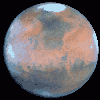 Recent observations with the
Hubble Space Telescope
(right)
have revealed that the conditions during the Viking missions
may not have been
typical. Mars' atmosphere now seems to be both colder and
dryer than
measured by the Viking landers.
(
more details from STScI)
Recent observations with the
Hubble Space Telescope
(right)
have revealed that the conditions during the Viking missions
may not have been
typical. Mars' atmosphere now seems to be both colder and
dryer than
measured by the Viking landers.
(
more details from STScI)
The Viking landers performed experiments to determine the existence of life on Mars. The results were somewhat ambiguous but most scientists now believe that they show no evidence for life on Mars (there is still some controversy, however). Optimists point out that only two tiny samples were measured and not from the most favorable locations. More experiments will be done by future missions to Mars.
A small number of meteorites (the SNC meteorites) are believed to have originated on Mars.
 On
1996 Aug 6, David McKay et al
announced the
first
identification of organic compounds in a Martian
meteorite. The
authors further suggest that these compounds, in conjunction
with a
number of other mineralogical features observed in the rock, may
be
evidence of ancient Martian microorganisms. (left)
On
1996 Aug 6, David McKay et al
announced the
first
identification of organic compounds in a Martian
meteorite. The
authors further suggest that these compounds, in conjunction
with a
number of other mineralogical features observed in the rock, may
be
evidence of ancient Martian microorganisms. (left)
Exciting as this is,
it is important to note while this evidence is strong it by no
means establishes
the fact of extraterrestrial life.
There have also been several contradictory studies published
since the McKay paper.
Remember, "extraordinary claims require extraordinary evidence."
Much work remains to be done before we
can be confident of this most extraordinary claim.
Large, but not global, weak magnetic fields exist in various regions of Mars. This unexpected finding was made by Mars Global Surveyor just days after it entered Mars orbit. They are probably remnants of an earlier global field that has since disappeared. This may have important implications for the structure of Mars' interior and for the past history of its atmosphere and hence for the possibility of ancient life.
When it is in the nighttime sky, Mars is easily visible with the unaided eye. Its apparent brightness varies greatly according to its relative position to the Earth. There are several Web sites that show the current position of Mars (and the other planets) in the sky. More detailed and customized charts can be created with a planetarium program such as Starry Night.
Distance Radius Mass
Satellite (000 km) (km) (kg) Discoverer Date
--------- -------- ------ ------- ---------- ----
Phobos 9 11 1.08e16 Hall 1877
Deimos 23 6 1.80e15 Hall 1877
("Distance" is measured from the center of Mars).
